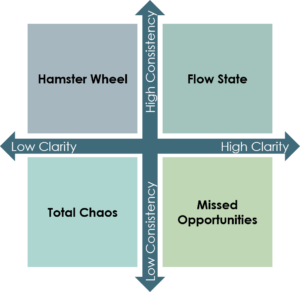Chaos Isn’t Failure—It’s a Signal
Let’s get one thing straight: chaos isn’t failure. It’s a signal. A flashing neon light telling you where your organization is struggling to keep up with its own growth or change. Yet so many leaders panic when chaos shows up, treating it as proof that they or their teams have somehow failed. That reaction? It’s a mistake.
Chaos is inevitable. It’s the uncomfortable price of doing business, of growing, of pushing boundaries. Whether you’re leading a scrappy startup, a government agency, or a legacy business trying to stay relevant, there’s no version of progress that doesn’t stir the pot. And when that pot starts to boil over, the challenge isn’t to make it stop—it’s to make sense of the mess.
This is where my Chaos to Clarity Grid comes in. It’s not about slapping a bandage on the symptoms of chaos; it’s about understanding its root causes. Every organization lands somewhere on a spectrum of clarity and consistency. Clarity is about knowing where you’re headed and why—it’s the “what” and “why” of your strategic goals. Consistency, on the other hand, is about action, the “how”—the ability to reliably and effectively execute those goals.
Picture a simple grid. Across one axis, you have clarity of strategic goals, from low to high. Across the other, you have consistency of action, also from low to high. These two factors combine to create four distinct organizational states:
- Total Chaos: No one knows what’s important, and even if they did, the team isn’t executing in a coordinated way.
- Hamster Wheel: Everyone is working hard, but it’s unclear if their actions align with the organization’s goals.
- Missed Opportunities: The vision is clear, but poor execution keeps derailing progress.
- Flow State: The holy grail—where clarity and consistency align to drive sustainable, productive progress.
It’s important to note that most organizations don’t fit neatly into just one quadrant. Instead, you’ll find pockets of teams, departments, or projects scattered across all four. One team might be spinning in the Hamster Wheel while another flounders in Total Chaos, and yet another is hitting its stride in Flow State. Chaos isn’t always loud or obvious—it can simmer quietly in the background, hidden behind busywork, or masked by small, repeated failures.
Chaos isn’t the enemy. In fact, it’s one of the most honest things your organization will ever show you. When you understand which quadrants different parts of your organization occupy, you gain invaluable insight into the specific challenges and opportunities at hand. The key isn’t to fix everything all at once but to tackle the areas with the highest impact first. Success builds on success; as alignment and consistency spread, so does momentum. This is how you move your organization steadily toward Flow State—not with superficial fixes but with thoughtful, incremental solutions that ripple outward.
Think of chaos as the signal that precedes transformation. If your team is constantly in Total Chaos, that’s your cue to ground yourselves in shared priorities. If you’re stuck in the Hamster Wheel, it’s time to challenge whether the work you’re doing even matters. If you’re consistently missing targets, you must focus on building systems that deliver, not just systems that look good on paper.
And if you’re in Flow State? Congratulations—but don’t get too comfortable. Even Flow State requires maintenance.
Chaos isn’t failure, but ignoring it is. The question isn’t whether chaos will appear in your organization but how you’ll respond when it does. Will you run from it, blame your team, or double down on the status quo? Or will you use it as the signal it is—the chance to transform your organization and finally reach the alignment and consistency you’ve been chasing?
Where Are You in the Grid?
Chaos shows up when there’s a gap between your organization’s intentions and its execution. You might have the best goals in the world, but if your team is floundering in how to achieve them, chaos creeps in. Or, maybe your team is a well-oiled machine in terms of action, but no one has paused to ensure those actions align with what really matters. That’s where the Chaos to Clarity Grid becomes a practical tool—it helps you assess where your organization, team, or department currently sits, so you can start to close the gap.
Let’s revisit the four quadrants:
- Total Chaos: Teams in this quadrant feel like they’re drowning. Priorities are unclear, and even if there’s a vague sense of direction, no one is rowing in sync. People are running in circles putting out fires, but nothing gets resolved, and everyone is constantly on edge.
- Hamster Wheel: This quadrant looks deceptively productive. People are working hard—sometimes to the point of exhaustion—but the activity doesn’t seem to move the needle. There’s no alignment between what’s being done and what really needs to be done. Burnout is common because teams feel like they’re spinning their wheels but going nowhere.
- Missed Opportunities: Here, the organization has clarity on where it wants to go but struggles to make meaningful progress. Deadlines are missed, execution is inconsistent, and frustration builds as well-laid plans fall apart time and again. Teams in this quadrant may have great intentions, but they’re constantly tripping over broken systems or a lack of follow-through.
- Flow State: This is the sweet spot where clarity of purpose and consistency of action come together. Teams trust each other, problems are solved before they escalate, and progress feels natural. While no organization stays in Flow State forever, those who reach it often see it as the foundation for sustainable success.
The beauty of the Chaos to Clarity Grid is that it’s not about judging your organization; it’s about understanding where you are so you can take action. No quadrant is permanent, and with the right focus, any team can move toward greater alignment and consistency.
Root Causes Across the Grid
Why do organizations end up in chaotic quadrants in the first place? The root causes often stem from the balance—or imbalance—between clarity and consistency.
- Total Chaos: This quadrant is a classic case of no shared goals or coordinated action. Teams don’t know what’s important, so everything feels urgent. Without clear priorities, even the best efforts become disjointed and ineffective.
- Hamster Wheel: Here, the root issue is prioritizing activity over impact. Leaders mistake busyness for progress, and teams end up overloaded with tasks that don’t contribute to the organization’s real objectives. It’s a recipe for burnout, as the lack of strategic alignment drains energy and morale.
- Missed Opportunities: The root cause here is often a lack of accountability or broken systems. Even with a clear vision, execution falters because responsibilities are unclear, timelines are unrealistic, or processes are riddled with inefficiencies. Teams are stuck in a cycle of good intentions undermined by poor follow-through.
What makes Flow State different? It’s not perfection—it’s a foundation of clarity and consistent action. Teams operating here know exactly what they’re working toward, and their systems and behaviors support that vision. They tackle problems head-on, communicate openly, and adjust as needed without losing momentum.
Recognizing the root causes behind chaos isn’t about assigning blame. It’s about identifying where the cracks are and focusing your energy on the fixes that matter most. Chaos thrives in uncertainty, but with a little clarity and consistent effort, you can turn it into a powerful opportunity for transformation.
Diagnosing and Navigating Chaos
This is where we get real. Chaos isn’t just a concept—it’s an everyday experience that can leave you frustrated, exhausted, and questioning everything. In this section, we will walk through each quadrant of the Chaos to Clarity Grid, giving you a checklist to identify where you are and practical actions to help you move forward.
Total Chaos
Are your days filled with putting out fires that never seem to stop? Does every conversation feel like a crisis meeting? When you’re in Total Chaos, it’s like standing in the middle of a storm with no shelter in sight. Everyone is running in different directions, trying to fix something—but no one knows what “fixed” even looks like. You’re constantly reacting, and the mental load never lets up.
Ask yourself:
- Do team members seem unsure about their priorities—or worse, argue over what they should be?
- Are decisions delayed because no one can agree on what’s important?
- Does progress feel impossible because every action creates two new problems?
Total Chaos doesn’t just burn teams out; it drains them of hope. When every day feels like survival mode, morale plummets, and turnover spikes. People feel like their work doesn’t matter because, honestly, it doesn’t—at least not in the absence of shared priorities.
Your Next Step:
- Start with one clear priority. What’s the one thing your team can rally around right now? It doesn’t have to be perfect or all-encompassing—just something you can all agree is worth tackling first.
- Create a basic plan. It doesn’t need to be fancy. Even a one-page document outlining who does what and by when can work wonders.
- Communicate relentlessly. Reiterate that priority in every meeting, email, and conversation until it feels impossible to ignore.
Hamster Wheel
Are you working nonstop but can’t explain why it matters? Do you struggle to define how the work you do every day contributes to the organization’s strategic goals? This is the Hamster Wheel—where effort doesn’t equal progress, and busyness becomes a badge of honor. The team is moving a hundred miles an hour, but no one is steering. It feels like productivity, but it’s actually just motion for motion’s sake.
Ask yourself:
- Do meetings feel endless and unproductive, leaving little time for actual work?
- Are team members constantly overwhelmed but unclear on what they’ve accomplished?
- Is there a sense of dread because you know you’re busy, but nothing seems to move the needle?
The Hamster Wheel eats away at motivation. People become frustrated when they’re working hard but seeing no impact. Burnout sets in, trust erodes, and everyone starts questioning whether any of it is worth it.
Your Next Step:
- Map it out. Take one day to map everything your team is doing. What are the recurring tasks, projects, and priorities?
- Kill one thing. Look for something you’re doing that doesn’t align with your goals. Cut it. Then, celebrate that decision as a team victory.
- Challenge the noise. Push back on unnecessary meetings, redundant reports, or work that exists “because we’ve always done it that way.”
Missed Opportunities
Are you frustrated by clear goals that never get met? In the Missed Opportunities quadrant, you know where you’re going—you just can’t seem to get there. The vision is solid, but execution breaks down under the weight of competing priorities, finger-pointing, or processes that look good on paper but fail in practice.
Ask yourself:
- Are deadlines frequently missed because urgent tasks constantly push priorities aside?
- Does it feel like no one is truly responsible for specific goals or outcomes, and self-preservation or blame takes precedence over solving the problem?
- Are processes technically in place, but they’re ignored, misunderstood, or bypassed when things get hectic?
Missed Opportunities create a culture of frustration and mistrust. Team members feel disheartened as well-intentioned efforts fail repeatedly. Blame spreads like wildfire, and fear of making mistakes overrides innovation and collaboration. Leaders find themselves asking, “Why aren’t we further along?” while employees feel stuck in a cycle of failure.
Your Next Step:
- Create “Safe to Own” Zones: Assign clear ownership for each goal or task, but pair this with a no-blame policy. Make it safe for individuals to own their responsibilities without fear of backlash if things go wrong. Emphasize collaboration over self-preservation.
- Reset the Priority Table: Revisit your goals and clarify what’s truly important right now. Agree as a team to pause or defer non-critical tasks, and make those adjustments visible to everyone.
- Audit Your Processes Together: Instead of imposing fixes from the top, gather the team to identify which processes are helpful and which ones are hindering progress. Start small by fixing one friction point as a group to rebuild trust in the system.
- Celebrate Progress, Not Perfection: Acknowledge incremental wins to keep morale up and show that moving in the right direction matters more than hitting every target perfectly.
Flow State
Are you operating with trust, alignment, and progress that feels natural? Welcome to Flow State—the quadrant where clarity and consistency converge. Here, people know their roles, understand the goals, and feel empowered to deliver. Challenges still arise, but they’re addressed proactively, not reactively.
Ask yourself:
- Does your team tackle problems before they escalate into crises?
- Are decisions made quickly and confidently because priorities are clear?
- Does everyone understand how their work contributes to the bigger picture?
Flow State doesn’t just feel good—it energizes teams. When work is meaningful and progress is real, people are more engaged, collaborative, and committed. Trust thrives because everyone knows they’re working toward the same goals.
Your Next Step:
- Keep asking, “What’s next?” Don’t assume the Flow State will maintain itself. Stay ahead by anticipating challenges and preparing for them.
- Reflect regularly. Build checkpoints to evaluate not just your results but how you achieved them.
- Celebrate often. Recognize the team’s big and small successes to sustain morale and reinforce what’s working.
Turn Chaos Into Opportunity
Chaos is your clue, signaling where things aren’t working and where they need your attention. The beauty of the Chaos to Clarity Grid is that it doesn’t just help you diagnose the chaos—it gives you a way forward. Whether your team is drowning in Total Chaos, spinning its wheels in the Hamster Wheel, tripping over Missed Opportunities, or riding high in Flow State, the grid offers a clear lens to identify challenges and actionable steps to address them.
The truth is that no organization fits neatly into one quadrant. You might have a project team hitting its stride in Flow State while another group flounders in Total Chaos. That’s okay. Progress isn’t about perfection—it’s about taking small, deliberate steps in the right direction. The secret to transforming chaos into clarity lies in focusing on what’s most urgent, tackling one priority at a time, and letting those wins build momentum.
Start small. If your team is in Total Chaos, pick one priority and get everyone on the same page. If you’re in the Hamster Wheel, challenge the value of your work and stop doing what doesn’t matter. For those stuck in Missed Opportunities, focus on clear ownership and rebuilding trust in your processes. And if you’re in Flow State, don’t get too comfortable—keep asking, “What’s next?” to stay ahead of the curve.
Every step toward clarity and consistency pays dividends—not just in the bottom line but in team morale, trust, and the sense that progress is possible. Chaos doesn’t have to be a permanent state. It’s a transition; when you treat it as an opportunity to grow, you’ll find that even the messiest moments can lead to success.
So, what comes next? Moving toward Flow State isn’t just about fixing the chaos—it’s about mastering the systems, behaviors, and practices that keep you there. Organizations in Flow State share five critical elements, and these pillars are the foundation for sustainable success. Want to know what they are?
- Download my parable book on chaos for an in-depth, relatable guide to mastering the transition from chaos to clarity. It’s full of practical insights and actionable advice to help you take your next steps.
Or, if you already know your chaos is too big to tackle alone:
- Let’s talk. Together, we’ll identify the root causes of your chaos and build a plan to get your organization moving in the right direction. Whether you need a coach, a consultant, or a conversation, I’m here to help.
Chaos is inevitable, but it’s also temporary. You don’t have to stay stuck. Start where you are, take action, and know that progress is always possible. Let’s turn chaos into your organization’s greatest opportunity.




